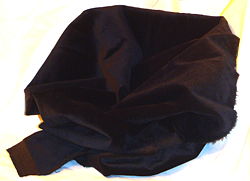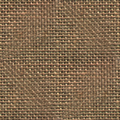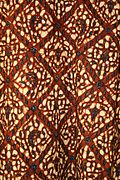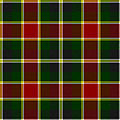- Velvet
-
This article is about the fabric. For other uses, see Velvet (disambiguation).
 Royal Military College of Canada gilt & red Velvet Victorian-era pre 1914 pin (Truth Duty Valour)
Royal Military College of Canada gilt & red Velvet Victorian-era pre 1914 pin (Truth Duty Valour)
Velvet is a type of woven tufted fabric in which the cut threads are evenly distributed,with a short dense pile, giving it a distinctive feel.
The word 'velvety' is used as an adjective to mean -"smooth like velvet".
Contents
Composition
Velvet is woven on a special loom that weaves two thicknesses of velvet at the same time. The two pieces are then cut apart to create the pile effect, and the two lengths of fabric are wound on separate take-up rolls. Velvet was expensive to make before industrial power looms became available. Velvet is difficult to clean because of its pile, but modern dry cleaning methods make cleaning more feasible. Velvet pile is created by warp or vertical yarns and velveteen pile is created by weft or fill yarns.
Velvet can be made from many different kinds of fibres, traditionally silk. Velvet made entirely from silk has market prices of several hundred US dollars per yard. Cotton can also be used, though this often results in a slightly less luxurious fabric. Velvet can also be made from fibers such as linen, mohair, and wool. A cloth made by the Kuba people of the Democratic Republic of Congo from raffia is often referred to as "Kuba velvet". More recently, synthetic velvets have been developed, mostly polyester, nylon, viscose, acetate, and mixtures of different synthetics, or synthetics and natural fibers (for example viscose mixed with silk). A small percentage of spandex is sometimes added to give stretch.
History
Velvet and Cashmere wool originated in Kashmir. Traditionally, velvet is associated with nobility. Velvet was introduced to Baghdad during the rule of Harun al-Rashid by Kashmiri merchants and to Al-Andalus by Ziryab. In the Mamluk era, Cairo was the world's largest producer of velvet. Much of it was exported to Venice, Al-Andalus and the Mali Empire. Musa I of Mali, the ruler of the Mali Empire, visited Cairo on his pilgrimage to Mecca. Many Arab velvet-makers accompanied him back to Timbuktu. Later Ibn Battuta mentions how Suleyman (mansa) the ruler of Mali wore a locally produced complete crimson Velvet caftan on Eid. During the reign of Mehmed II, assistant cooks wore blue coloured dresses (câme-i kebûd), conical hats (külâh) and baggy trousers (çaksir) made from Bursa velvet.[citation needed]
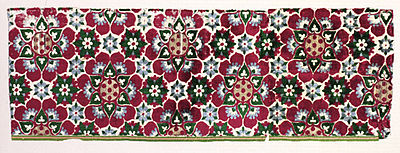 Velvet with Medici Arms, Florence or Venice, 1440–1500
Velvet with Medici Arms, Florence or Venice, 1440–1500
The art of velvet-weaving probably originated in medieval Kashmir around the beginning of the fourteenth century.[citation needed]
King Richard II of England directed in his will that his body should be clothed in velveto in 1399.[1]
The earliest sources of European artistic velvets were Lucca, Genoa, Florence and Venice, and Genoa continues to send out rich velvet textures. Somewhat later the art was taken up by Flemish weavers, and in the 16th century Bruges attained a reputation for velvets that were not inferior to those of the great Italian cities.
Types
- Crushed: This type of velvet can be produced by pressing the fabric down in different directions. It can also be produced by mechanically twisting the fabric while wet. The result is patterned appearance that is very lustrous.[2]
- Devore: This variety is produced with a caustic solution. This dissolves part of the velvet leaving sheer areas of fabric. Usually a definite pattern is produced.[2]
- Embossed: A metal roller is used to heat-stamp the fabric, producing a pattern.[2]
- Hammered: This type is extremely lustrous, appears dappled, and somewhat crushed.[2]
- Panné: Also a type of crushed velvet, panné is produced by forcing the pile in a single direction by applying heavy pressure.[3]
- Plain: Commonly made of cotton, this type of velvet has a firm hand and can be used for many purposes.[2]
- Silk: More expensive than plain velvet, this type is usually shinier and softer than the cotton variety.[2]
- Viscose: In terms of quality, this type is more similar to silk velvet than cotton velvet.[2]
- Velveteen is a type of imitation velvet.[3] It is normally made of cotton or a combination of cotton and silk. It has a pile that is short (never more than 3mm deep), and is closely set. It has a firm hand, and a slightly sloping pile. Unlike true velvet, this type has greater body, does not drape as easily, and has less sheen.[2]
See also
- Corduroy
- Glossary of textile manufacturing
- Velour, or velours, a plush, knitted fabric or textile
- Velvet painting
References
- ^ L W Cowrie Dictionary of British Social History Wordsworth Reference p.304 ISBN 1-85326-378-8
- ^ a b c d e f g h "Free patterns - Velvet". sewingtechnology.net. http://www.sewingtechnology.net/page39.htm.
- ^ a b "Fabric Properties and Distinctions - Velvet". fabrics.net. http://www.fabrics.net/amyvelvet.asp.
 This article incorporates text from a publication now in the public domain: Chisholm, Hugh, ed (1911). Encyclopædia Britannica (11th ed.). Cambridge University Press.Categories:
This article incorporates text from a publication now in the public domain: Chisholm, Hugh, ed (1911). Encyclopædia Britannica (11th ed.). Cambridge University Press.Categories:- Pile fabrics
Wikimedia Foundation. 2010.

